
The seventh House select committee hearing on the January 6 attack at the Capitol examined in detail how then-President Trump went against the advice of top aides to claim President Biden’s win was fraudulent and to strategize a means to overturn the election. Tuesday’s hearing focused in part on a tweet Trump sent on December 19, 2020, in which he called for a “big protest” at the coming joint session of Congress on January 6 and told his supporters, “Be there, will be wild!” Committee member, Democratic Congressmember Jamie Raskin lays out how Trump sent the tweet just about an hour after a tense meeting at the White House between his official and unofficial advisers that was described in testimony as “unhinged,” and features excerpts of deposition testimony from Trump lawyer Sidney Powell, White House lawyer Eric Herschmann and White House counsel Pat Cipollone, among others.
Transcript
AMY GOODMAN: This is Democracy Now!, democracynow.org, The War and Peace Report. I’m Amy Goodman.
A major focus of Tuesday’s hearing of the House Select Committee to Investigate the January 6th Attack on the United States Capitol was a tweet that was sent by then-President Trump on December 19, 2020. In the tweet, Trump called for a “big protest” at the coming joint session of Congress on January 6th and told his supporters, “Be there, will be wild!” Trump sent the tweet one day after a tense meeting at the White House between his official and unofficial advisers that was described in testimony as “unhinged.”
Committee member Jamie Raskin laid out in detail how the meeting unfolded and how the tweet ultimately led some of Trump’s most extreme and violent supporters to attack the Capitol. Raskin featured excerpts of video deposition testimony from Trump lawyer Sidney Powell, White House lawyer Eric Herschmann and White House counsel Pat Cipollone, among others. This is Congressmember Raskin.
REP. JAMIE RASKIN: So, let’s return to that meeting at the White House on the evening of December 18. That night, a group showed up at the White House including Sidney Powell, retired Lieutenant General Michael Flynn and former Overstock.com CEO Patrick Byrne.
After gaining access to the building from a junior White House staffer, the group made their way to the Oval Office. They were able to speak with the president by himself for some time until White House officials learned of the meeting. What ensued was a heated and profane clash between this group and President Trump’s White House advisers, who traded personal insults, accusations of disloyalty to the president, and even challenges to physically fight.
The meeting would last over six hours, beginning here, in the Oval Office, moving around the West Wing, and many hours later ending up in the president’s private residence. The select committee has spoken with six of the participants, as well as staffers who could hear the screaming from outside the Oval Office. What took place next is best told in their own words, as you will see from this video.
INVESTIGATOR: Did you believe that it was going to work, that you were going be able to get to see the president without an appointment?
SIDNEY POWELL: I had no idea.
INVESTIGATOR: In fact, you did get to see the president without an appointment.
SIDNEY POWELL: We did.
INVESTIGATOR: How much time did you have alone with the president? I say “alone”; you had other people with you. But —
SIDNEY POWELL: Right.
INVESTIGATOR: — I think, from his aides before the crowd came running.
SIDNEY POWELL: Probably no more than 10 or 15 minutes.
INVESTIGATOR: Was in that —
SIDNEY POWELL: I bet Pat Cipollone set a new land speed record.
PAT CIPOLLONE: I got a call, either from Molly or from Eric Herschmann that I need to get to the Oval Office.
CASSIDY HUTCHINSON: So, that was the first point that I had recognized, OK, there is nobody in there from the White House. Mark’s gone. What’s going on right now?
PAT CIPOLLONE: I opened the door, and I walked in. I saw General Flynn. I saw Sidney Powell sitting there. I was not happy to see the people who were in the Oval Office.
INVESTIGATOR: Explain why.
PAT CIPOLLONE: Well, again, I don’t think they were providing — well, first of all, that Overstock person, I’ve never met — never, didn’t know who this guy was. Actually, the first thing I did, I walked in, I looked at him, and I said, “Who are you?” And he told me. I don’t think — I don’t think any of these people were providing the president with good advice. And so, I didn’t understand how they had gotten in.
INVESTIGATOR: In the short period of time that you had with the president, did he seem receptive to the presentation that you were making?
SIDNEY POWELL: He was very interested in hearing particularly about the CISA findings and the terms of 13848, that apparently nobody else had bothered to inform him of.
AMY GOODMAN: That’s Sidney Powell.
ERIC HERSCHMANN: And I was asking, like, “Are you claiming the Democrats were working with Hugo Chávez, Venezuelans and whomever else?” And at one point General Flynn took out a diagram that supposedly showed IP addresses all over the world and — or who was — who was communicating with whom via the machines, and some comment about, like, Nest thermostats being hooked up to the internet.
AMY GOODMAN: That was Eric Herschmann.
INVESTIGATOR: So, it’s been reported that during this meeting, Ms. Powell talked about Dominion voting machines and made various election fraud claims that involve foreign countries, such as Venezuela, Iran and China. Is that accurate?
MICHAEL FLYNN: The fifth.
INVESTIGATOR: Was the meeting tense?
DEREK LYONS: Oh, yeah. It was not a casual meeting.
AMY GOODMAN: That was Derek Lyons, White House aide.
INVESTIGATOR: Explain.
DEREK LYONS: I mean, at times there were people shouting at each other, hurling insults at each other. It wasn’t just sort of people sitting around on a couch like chit-chatting.
INVESTIGATOR: Do you recall whether he raised to Ms. Powell the fact that she and the campaign had lost all of the 60 cases that they had brought in litigation?
AMY GOODMAN: Pat Cipollone.
PAT CIPOLLONE: Yes, he raised that.
INVESTIGATOR: And what was the response?
PAT CIPOLLONE: I don’t remember what she said. I don’t think it was a good response.
SIDNEY POWELL: Cipollone and Herschmann and whoever the other guy was showed nothing but contempt and disdain of the president.
PAT CIPOLLONE: I remember the three of them were really sort of forcefully attacking me — and verbally — Eric, Derek. And we were pushing back, and we were asking one simple question —
AMY GOODMAN: Again, that’s Cipollone.
PAT CIPOLLONE: — as a — as a general matter: Where is the evidence? So.
INVESTIGATOR: What response did you get when you asked Ms. Powell and her colleagues where’s the evidence?
PAT CIPOLLONE: A variety of responses, based on my current recollection, including, you know, “Can’t believe you would say something like” — you know, things like this. Like, “What do you mean, ’Where’s the evidence?’ You should know.” Yeah, and things like that or, you know, a disregard, I would say, a general disregard, for the importance of actually backing up what you say with facts.
DEREK LYONS: And, you know, then there was discussion of, “Well, you know, we don’t have it now, but we will have it,” or whatever.
SIDNEY POWELL: I mean, if — if it had been me sitting in his chair, I would have fired all of them that night and had them escorted out of the building.
ERIC HERSCHMANN: Which Derek and I both challenged what she was saying. And she says, “Well, the judges are corrupt.” And I was like, “Every one? Every single case that you’ve done in the country you guys lost, every one of them is corrupt? Even the ones we appointed?” And I’m being nice. I was much more harsh to her.
AMY GOODMAN: That’s Eric Herschmann.
INVESTIGATOR: So, one of the other things that’s been reported that was said during this meeting was that President Trump told White House lawyers Mr. Herschmann and Mr. Cipollone that they weren’t offering him any solutions, but Ms. Powell and others were. So why not try what Ms. Powell and others were proposing? Do you remember anything along those lines being said by President Trump?
DEREK LYONS: I do. That sounds right.
ERIC HERSCHMANN: I think that it got to the point where the screaming was completely, completely out there. I mean, you got people walk in. It was late at night, had been a long day. And what they were proposing, I thought, was nuts.
RUDY GIULIANI: I’m gonna — I’m gonna categorically describe it as “You guys are not tough enough.” Or maybe I put it another way: “You’re a bunch of pussies.” Excuse the expression, but that’s, I — I’m almost certain the word was used.
ERIC HERSCHMANN: Flynn screamed at me that I was a quitter and everything, kept on standing up and turning around and screaming at me. And at a certain point I had it with him. So I yelled back, “Better come over. Better sit your effing ass back down.”
RUDY GIULIANI: The president and the White House team went upstairs to the residence, but to the —
AMY GOODMAN: This is Rudolph Giuliani.
RUDY GIULIANI: — public part of the residence, you know, the big — the big parlor where you can have meetings in the conference room.
INVESTIGATOR: Yellow Oval? They call it the Yellow Oval?
RUDY GIULIANI: Yes, exactly, the Yellow Oval Office. I always called it the upper. And I’m not exactly sure where the Sidney group went, I think maybe the Roosevelt Room. And I stayed in the Cabinet Room, which is kind of cool — I really liked that — all by myself.
DEREK LYONS: At the end of the day, we landed where we started the meeting, at least from a structural standpoint, which was Sidney Powell was fighting. Mike Flynn was fighting. They were looking for avenues that would enable — that would result in President Trump remaining President Trump for a second term.
REP. JAMIE RASKIN: The meeting finally ended after midnight. Here are text messages sent by Cassidy Hutchinson during and after the meeting. As you can see, Ms. Hutchinson reported that the meeting in the West Wing was “unhinged.” The meeting finally broke up after midnight. During the early morning of December 19, Cassidy Hutchinson captured the moment of Mark Meadows escorting Rudy Giuliani off the White House grounds to, quote, “make sure he didn’t wander back [to] the Mansion.” Certain accounts of this meeting indicate that President Trump actually granted Ms. Powell security clearance and appointed her to a somewhat ill-defined position of special counsel.
SIDNEY POWELL: He asked Pat Cipollone if he had the authority to name me special counsel, and he said yes. And then he asked him if he had the authority to give me whatever security clearance I needed, and Pat Cipollone said yes. And then the president said, “OK, you know, I’m the naming her that, and I’m giving her security clearance.” And then, shortly before we left and it totally blew up was when Cipollone and/or Herschmann and whoever the other young man was said, “You can name her whatever you want to name her, and no one’s going to pay any attention to it.”
INVESTIGATOR: How did he respond? How did the president respond to that?
SIDNEY POWELL: Something like, “You see what I deal with. I deal with this all the time.”
REP. JAMIE RASKIN: Over the ensuing days, no further steps were taken to appoint Sidney Powell, but there is some ambiguity about what the president actually said and did during the meeting. Here is how Pat Cipollone described it.
PAT CIPOLLONE: I don’t know what her understanding of whether she had been appointed, what she had been appointed to, OK? In my view, she hadn’t been appointed to anything, and ultimately wasn’t appointed to anything, because there had to be other steps taken. And that was my view when I left the meeting. But she may have a different view, and others may have a different view, and the president may have a different view.
REP. LIZ CHENEY: Were any steps taken, including the president himself telling her she had been appointed?
PAT CIPOLLONE: Again, I’m not going to get into what the president said in the meeting. You know, my recollection is you’re not appointed even — you’re not appointed 'til steps are taken to get the paperwork done, get — and when I left the meeting, OK, I guess — I guess what I'm trying to say is I’m not going to get into what the president said or said he wanted.
REP. JAMIE RASKIN: Mr. Cipollone, when the matter continued to flare up over the next several days, was it your understanding that Sidney Powell was still seeking an appointment or that she was asserting that she had been appointed by the president at the December 18 meeting?
PAT CIPOLLONE: You know, now that you mention it, probably both, you know, in terms of like I think she was — I think she may have been of the view that she had been appointed and was seeking to, you know, get that done, and — and that she should be appointed.
REP. JAMIE RASKIN: As you listen to these clips, remember that Ms. Powell, the person who President Trump tried to make special counsel, was ultimately sanctioned by a federal court and sued by Dominion Voting Systems for defamation. In her own defense to that lawsuit, Sidney Powell argued that, quote, “no reasonable person would conclude that the statements were truly statements of fact.”
Not long after Sidney Powell, General Flynn and Rudy Giuliani left the White House in the early hours of the morning, President Trump turned away from both his outside advisers’ most outlandish and unworkable schemes and his White House counsel’s advice to swallow hard and accept the reality of his loss.
Instead, Donald Trump issued a tweet that would galvanize his followers, unleash a political firestorm and change the course of our history as a country. Trump’s purpose was to mobilize a crowd. And how do you mobilize a crowd in 2020? With millions of followers on Twitter, President Trump knew exactly how to do it.
At 1:42 a.m. on December 19, 2020, shortly after the last participants left the unhinged meeting, Trump sent out the tweet with his explosive invitation. Trump repeated his big lie and claimed it was, quote, “statistically impossible to have lost the 2020 Election,” before calling for a “Big protest in D.C. on January 6th. Be there, will be wild!”
Trump supporters responded immediately. Women for America First, a pro-Trump organizing group, had previously applied for a rally permit for January 22nd and 23rd in Washington, D.C., several days after Joe Biden was to be inaugurated. But in the hours after the tweet, they moved their permit to January 6th, two weeks before. This rescheduling created the rally where Trump would eventually speak.
The next day, Ali Alexander, leader of the Stop the Steal organization and a key mobilizer of Trump supporters, registered WildProtest.com, named after Trump’s tweet. WildProtest.com provided comprehensive information about numerous newly organized protest events in Washington. It included event times, places, speakers and details on transportation to Washington, D.C.
Meanwhile, other key Trump supporters, including far-right media personalities, began promoting the “wild protest” on January 6th.
ALEX JONES: It’s Saturday, December 19th. The year is 2020. And one of the most historic events in American history has just taken place.
AMY GOODMAN: That’s Alex Jones.
ALEX JONES: President Trump, in the early-morning hours today, tweeted that he wants the American people to march on Washington, D.C., on January 6, 2021.
TIM POOL: And now Donald Trump is calling on his supporters to descend on Washington, D.C., January 6th.
ALEX JONES: He is now calling on We the People to take action and to show our numbers.
MATT BRACKEN: We’re going to only be saved by millions of Americans moving to Washington, occupying the entire area, if — if necessary, storming right into the Capitol. You know, they’re — we know the rules of engagement. If you have enough people, you can push down any kind of a fence or a wall.
TIM POOL: This could be Trump’s last stand. And it’s a time when he has specifically called on his supporters to arrive in D.C. That’s something that may actually be the big push Trump supporters need to say this is it. It’s now or never.
SALTY CRACKER: Ya better understand something, son. Ya better understand something. Red wave, bitch. Red wave — there’s gonna be a red wedding going down January 6th.
TIM POOL: On that day, Trump says, “Show up for a protest. It’s gonna be wild.” And based on what we’ve already seen from the previous events, I think Trump is absolutely correct.
SALTY CRACKER: Mother [bleep], you better look outside. You better look out January 6th. Kick that [bleep] door open, look down the street. There are gonna be a million-plus geeked-up armed Americans.
ALEX JONES: The time for games is over. The time for action is now. Where were you when history called? Where were you when you and your children’s destiny and future was on the line?
REP. JAMIE RASKIN: In that clip, you heard one of Trump’s supporters predict a red wedding, which is a pop culture reference to mass slaughter. But the point is that Trump’s call to Washington reverberated powerfully and pervasively online.
The committee has interviewed a former Twitter employee who explained the effect that Trump had on the Twitter platform. This employee was on the team responsible for platform and content moderation policies on Twitter throughout 2020 and 2021. The employee testified that Twitter considered adopting a stricter content moderation policy after President Trump told the Proud Boys to “stand back and stand by” from the lectern at the September 29th presidential debate, but Twitter chose not to act.
Here’s the former employee, whose voice has been obscured to protect their identity, discussing Trump’s “stand back and stand by” comment and the effect it had.
FMR. TWITTER EMPLOYEE: My concern was that the former president, for seemingly the first time, was speaking directly to extremist organizations and giving them directives. We had not seen that sort of direct communication before, and that concerned me.
INVESTIGATOR: So, just to clarify further, you were worried, and others at Twitter were worried, that the president might use your platform to speak directly to folks who might be incited to violence?
FMR. TWITTER EMPLOYEE: Yes. I believe that Twitter relished in the knowledge that they were also the favorite and most used service of the former president, and enjoyed having that sort of power within the social media ecosystem.
INVESTIGATOR: If President Trump were anyone else, would it have taken until January 8th, 2021, for him to be suspended?
FMR. TWITTER EMPLOYEE: Absolutely not. If Donald — if the former President Donald Trump were any other user on Twitter, he would have been permanently suspended a very long time ago.
REP. JAMIE RASKIN: Despite these grave concerns, Trump remained on the platform completely unchecked. Then came the December 19 tweet, and everything it inspired. Indeed —
FMR. TWITTER EMPLOYEE: It was — it felt as if — if a mob was being organized, and they were gathering together their weaponry and their logic and their reasoning behind why they were prepared to fight. Prior to December 19th, again, it was vague. It was — it was nonspecific, but very clear that individuals were ready, willing and able to take up arms. After this tweet on December 19th, again, it became clear not only were these individuals ready and willing, but the leader of their cause was asking them to join him in this cause and in fighting for this cause in D.C. on January 6th, as well.
I will also say what shocked me was the responses to these tweets, right? So, these were — a lot of the “locked and loaded,” “stand back, stand by,” those tweets were in response to Donald Trump saying things like this, right? So, there would be a response that said, “Big protest in D.C. on January 6th. Be there, be wild,” and someone would respond and say, “I’m locked and loaded and ready for civil war part two,” right?
I very much believe that Donald Trump posting this tweet on December 19th was essentially staking a flag in D.C. on January 6th for his supporters to come and rally.
INVESTIGATOR: And you were concerned about the potential for this gathering becoming violent?
FMR. TWITTER EMPLOYEE: Absolutely.
REP. JAMIE RASKIN: Indeed, many of Trump’s followers took to social media to declare that they were ready to answer Trump’s call. One user asked, “Is the 6th D-Day? Is that why Trump wants everyone there?” Another asserted, “Trump just told us all to come armed. [Bleep] A, this is happening.” A third took it even further: “It 'will be wild' means we need volunteers for the firing squad.”
Jim Watkins, the owner of 8kun, the fringe online forum that was birthplace of the QAnon extremist movement, confirmed the importance of Trump’s tweet.
INVESTIGATOR: Why did you first decide to go to D.C. for January 6th?
JIM WATKINS: When the president of the United States announced that he was going to have a rally, then I bought ticket and went.
REP. JAMIE RASKIN: Watkins was at the Capitol on January 6th.
Some who have since been indicted for their involvement in the attack on the Capitol also responded. One of them posted on the 19th, quote, ”CALLING ALL PATRIOTS! Be in Washington D.C. January 6th. This wasn’t organized by any group. DJT has invited us and it’s going to be 'wild.'”
Some of the online rhetoric turned openly homicidal and white nationalist, such as, “Why don’t we just kill them? Every last democrat, down to the last man, woman, and child?” and “It’s time for the DAY OF THE ROPE! WHITE REVOLUTION IS THE ONLY SOLUTION!”
Others realized that police would be standing in the way of their effort to overturn the election, so one wrote, “I’m ready to die for my beliefs. are you ready to die police?” Another wrote on TheDonald.win, “Cops don’t have 'standing' if they are laying on the ground in a pool of their own blood.”
TheDonald.win was an openly racist and antisemitic forum. The select committee deposed that site’s founder, Jody Williams. He confirmed how the president’s tweet created a laser-like focus on the date of January the 6th.
JODY WILLIAMS: And people had been talking about going to D.C. since the election was over.
INVESTIGATOR: And do you recall whether or not the conversation around those dates centered on the 6th after the president’s tweet?
JODY WILLIAMS: Oh, sure, yeah. I mean, after it was announced that, you know, he was going to be there on the 6th to talk, yes. Then — then anything else was kind of shut out, and it was just gonna be on the 6th.
INVESTIGATOR: OK. And that was pretty clearly reflected in the content on the site?
JODY WILLIAMS: Yeah, yeah, sure.
REP. JAMIE RASKIN: On that site, many shared plans and violent threats. “Bring handcuffs and wait near the tunnels,” wrote one user. A commenter replied suggesting zip ties instead. One post encouraged others to come with “Body armor, knuckles, shields, bats, pepper spray, whatever it takes.” All of those were used on the 6th. The post concluded, ”JOIN YOUR LOCAL PROUD BOYS CHAPTER AS WELL.”
TheDonald.win featured discussions of the tunnels beneath the Capitol complex, suggestions for targeting members of Congress, and encouragement to attend this “Once in a lifetime event.”
While Trump supporters grew more aggressive online, he continued to rile up his base on Twitter. He said there was “overwhelming evidence” that the election was “the biggest SCAM in our nation’s history.” As you can see, the president continued to boost the event, tweeting about it more than a dozen times in the lead-up to January the 6th.
AMY GOODMAN: January 6th House committee member, Congressman Jamie Raskin at Tuesday’s hearing. We’ll be back with more in a minute.

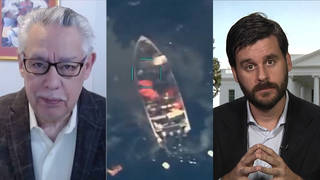
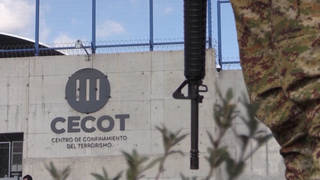
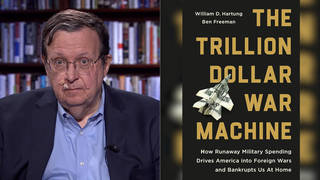
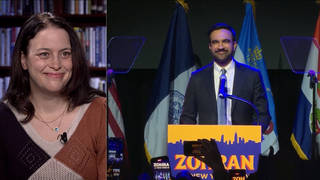





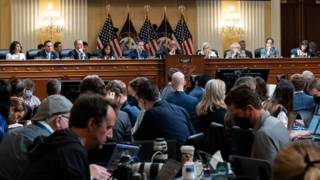
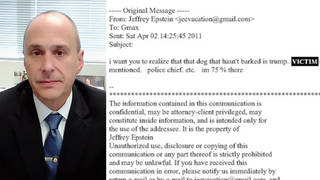
Media Options